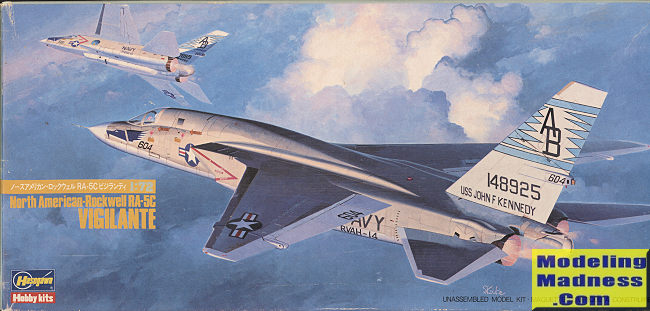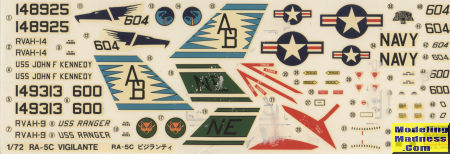
Hasegawa 1/72 RA-5C Vigilante
| KIT #: | 805 |
| PRICE: | $5.00 'used' |
| DECALS: | Three |
| REVIEWER: | Scott Van Aken |
| NOTES: |

| HISTORY |
The Vigilante's early service proved troublesome, with many teething problems for its advanced systems. Although these systems were highly sophisticated, the technology was in its infancy, and its reliability was poor. Although most of these reliability issues were eventually worked out as maintenance personnel gained greater experience with supporting these systems, the aircraft tended to remain a maintenance-intensive platform throughout its career.
The A-5's service coincided with a major policy shift in the U.S. Navy's strategic role, which switched to emphasize submarine-launched ballistic missiles rather than manned bombers. As a result, in 1963, procurement of the A-5 was ended and the type was converted to the fast reconnaissance role.
The first RA-5Cs were delivered to VAH-3, the A-5A and A-5B Replacement Air Group (RAG)/Fleet Replacement Squadron (FRS), subsequently redesignated as Reconnaissance Attack Squadron Three (RVAH-3), at NAS Sanford, Florida in July 1963. As they transitioned from the attack version to the reconnaissance version, all Vigilante squadrons were subsequently redesignated from VAH to RVAH.
Despite the Vigilante's useful service, it was expensive and complex to operate and occupied significant amounts of precious flight deck and hangar deck space aboard both conventional and nuclear-powered aircraft carriers at a time when carrier air wings, with the introduction of the F-14 Tomcat and S-3 Viking, were averaging 90 aircraft, many of which were larger than their predecessors. With the end of the Vietnam War, disestablishment of RVAH squadrons began in 1974, with the last Vigilante squadron, RVAH-7, completing its final deployment to the Western Pacific aboard USS Ranger in late 1979. The final flight by an RA-5C took place on 20 November 1979 when a Vigilante departed NAS Key West, Florida. Reconnaissance Attack Wing One was subsequently disestablished at NAS Key West, Florida in January 1980.
| THE KIT |
 The
Vigilante is one of those aircraft that has seen a few kits, but due to the
nature of the beast (inability to do multiple variants), those kits have been
few and far between. In 1/72 scale or so, there has been a box scale A-5A by
Revell and a 1/72 Monogram kit that included a spring loaded mechanism to allow
a bomb/torpedo to be ejected out the back. This Hasegawa kit was probably the
third one kitted. Since then there was an Airfix and Revell offering along
with the much maligned Trumpeter kit which is the latest attempt at an upgraded
Vigi.
The
Vigilante is one of those aircraft that has seen a few kits, but due to the
nature of the beast (inability to do multiple variants), those kits have been
few and far between. In 1/72 scale or so, there has been a box scale A-5A by
Revell and a 1/72 Monogram kit that included a spring loaded mechanism to allow
a bomb/torpedo to be ejected out the back. This Hasegawa kit was probably the
third one kitted. Since then there was an Airfix and Revell offering along
with the much maligned Trumpeter kit which is the latest attempt at an upgraded
Vigi.
One could easily call this a first generation Hasegawa kit as it has fairly thick, hard plastic and raised panel lines. The cockpit is basically seat shapes on which one placed crew figures. The back seater's windows need to be installed prior to gluing the fuselage halves. There is an instrument panel that takes a decal. This is installed in the fuselage halves and then a fairing behind the cockpit and the intakes are attached. These have no real depth. On the underside there is a tail hook section and one can have the hook drop down. On the upper rear is a slab section into which one attaches the fin. The horizontal stabs are trapped by the exhaust section. Since you'll probably do a lot of sanding on this, I'd recommend cutting the connected stabs and install those after painting.
Gear wells have some detail, and I'm betting it is
fictitious. Landing gear is adequate as are the wheels. You'll have to deal with
ejector marks on most of the small bits. Gear doors are far too thick with no
real detail. Wings are upper and lower halves with the pylon holes already
drilled. The pylons and fuel tanks are little more than close shapes with little
detail. The ventral canoe requiers four clear pieces to be installed. The single
piece canopy has very faint frame lines. Test fit everything as you'll generally
find parts don't fit all that well.

Instructions are standard old style with generic color information. Two markings options are provided, both in light gull grey over white. My kit had obviously been wet at some time as the decals had partially stuck to the instructions. Fortunately, there are alternatives out there. The two units are the box art version from RVAH-14 aboard the USS JFK and the other is RVAH-9 aboard the USS Ranger.
| CONCLUSIONS |
I don't think the kit is in Hasegawa's current catalogue, but you can easily find one with a modicum of searching. Worth building? If you already have one, then probably so. Otherwise I'd recommend one of the newer toolings.
| REFERENCES |
https://en.wikipedia.org/wiki/North_American_A-5_Vigilante
February 2019 Copyright ModelingMadness.com. All rights
reserved. If you would like your product reviewed fairly and fairly quickly, please contact the editor or see other details in the
Note to
Contributors. Back to the Main Page
Back to the Review
Index Page
Back to the Previews Index Page